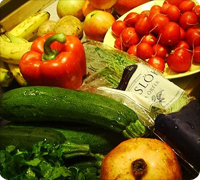Difference Between Organic and Inorganic Food
 Organic vs Inorganic Food
Organic vs Inorganic Food
Over the past two decades the world has become increasingly health and environmentally conscious. The world of social activism is no longer confined to protest marches and leaflet campaigns. Today, consumers realize that they have the power to evoke change by voting with the most important tool at their disposal, their wallets. Today, it is a well known fact that if you want a cleaner environment and healthier food you should choose organic products.
What makes food organic? In strictly scientific terms, organic substances contain carbon, the building block of life. By this definition, everything that we eat is technically organic. However, agricultural parlance has changed the definition of organic when it relates to food and other consumables. Inorganic food encompasses everything that organic food is not.
Organic food must be free from all synthetic chemicals.
This starts at the ground level when a farmer prepares his field. He cannot use any petroleum-based fertilizer or chemically altered material in his soil. Manure and compost are acceptable natural products; Miracle Gro is not.
Chemicals are also not allowed for pest or disease control. A farmer can treat his crops with insecticidal soap or neem oil, but cannot use store-bought sprays unless they are certified organic.
Organic food cannot be genetically altered in any way.
Traditionally, changes to plants and livestock were accomplished through selective breeding techniques and hand pollination. These techniques are still certified organic.
Genetically modified food, or GM food, has been tampered with at the genetic level. Sometimes varieties of plants have been cross-bred to create hardier or tastier strains. GM seeds can be drought resistant or have higher yields. Purists feel GM technology tampers with the work of Mother Nature and is therefore inorganic.
Organic food cannot come in contact with inorganic food.
In order to ensure that pesticides or other chemical treatments don’t rub off on organic produce, it must be packaged and shipped separately from conventionally farmed food.
Proponents of organic food say that the products are healthier than conventional produce. Fewer chemicals mean fewer carcinogens. They also say that the food just tastes better. At the same time, organic soil may still produce run-off, but it isn’t toxic run-off that will permanently damage the water table. Animals that are fed exclusively on organic products, such as free-range chickens or grass-fed beef are generally believed to be treated more humanely, though this isn’t always the case.
Summary:
1. Organic and inorganic foods are differentiated by their farming processes, not their chemical makeup.
2. Organic food is chemical free, GM free, and free from contact with inorganic food while inorganic food is anything that doesn’t meet those strict guidelines.
3. Many consumers believe that organic food is healthier, tastes better, and is better for the environment than inorganic food.
- Difference Between Schizophrenia and Psychosis - March 7, 2024
- Difference Between African and Asian Elephants - March 7, 2024
- Difference Between Sunscreen and Sunblock - February 15, 2024
Search DifferenceBetween.net :
 Email This Post
: If you like this article or our site. Please spread the word. Share it with your friends/family.
Email This Post
: If you like this article or our site. Please spread the word. Share it with your friends/family.


My spouse and I absolutely love your blog and find the majority of
your post’s to be precisely what I’m looking for. can you offer guest writers to write content to suit your needs? I wouldn’t mind publishing a post or elaborating on a few of the subjects you write with regards to here. Again, awesome blog!
Quality articles is the main to attract the viewers to go to see the site, that’s what this web site is providing.